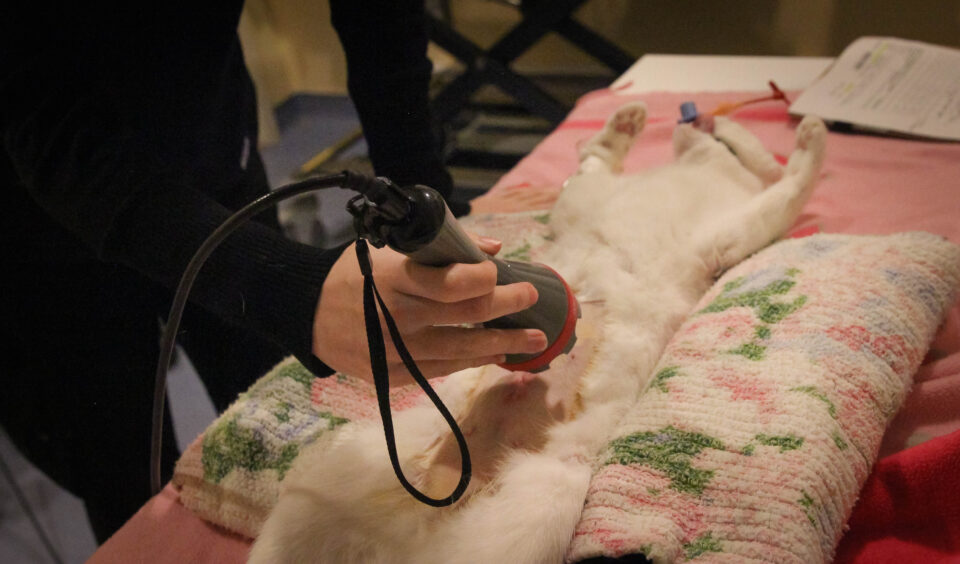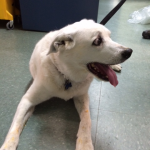Laser Therapy

Benefits of Laser Therapy
Laser Therapy accelerates the body’s natural healing process through photo-bio-modulation. Laser therapy provides tangible benefits to our patients. Laser therapy is effective in treating chronic conditions, acute conditions, and post- surgical pain and inflammation.
Clinical Benefits
→ Non-pharmacologic pain relief
→ Effective for difficult conditions
→ Alternative to surgery
→ Fast treatment times
→ Easy, comfortable, non-invasive treatment
→ Scientifically-proven
Biological Effects
Decades of research, clinical trials, and laboratory testing indicate the following beneficial effects of laser therapy:
Anti-Inflammation
Laser Therapy reduces inflammation with vasodilation, activation of the lymphatic drainage system, and reduction of pro-inflammatory mediators. As a result, inflammation, erythema, bruising, and edema are reduced.
Analgesic Effect
Laser Therapy of diseased and damaged tissue produces a suppression of nociceptors, an increase of stimulation threshold, and an increased release of tissue endorphins. The result is a decreased patient perception of pain.
Accelerated Tissue Repair and Cell Growth
Photons of light from lasers penetrate deeply into tissue and accelerate cellular reproduction and growth. Laser light increases the energy available to the cells so that they can take on nutrients and get rid of waste products more quickly.
Improved Vascular Activity
Laser light significantly increases the formation of new capillaries in damaged tissue. This speeds the healing process, resulting in more rapid wound closure.
Increased Metabolic Activity
The energy from photons of laser light is captured by chemical complexes within cells resulting in activation of enzyme systems and increased energy delivered into cellular metabolic processes.
Trigger Points and Acupuncture Points
Laser therapy stimulates muscle trigger and acupuncture points without mechanical invasion to provide musculoskeletal pain relief.
Reduced Fibrous Tissue Formation
Laser Therapy reduces the formation of scar tissue.
Improved Nerve Function
Slow recovery of nerve functions in damaged tissue results in numbness and impaired limbs. Laser therapy accelerates nerve cell regeneration.
Immunoregulation
Therapy laser photons have an effect on immune systems status through stimulation of immunoglobins and lymphocytes. Laser therapy energy is absorbed by chromophores (molecular enzymes) that react to laser light. The enzyme flavomono-nucleotide is activated and starts the production of ATP, which is the major carrier of cellular energy and the energy source for all chemical reactions in the cells.
Faster Wound Healing
Laser light stimulates fibroblast development. Fibroblasts produce collagen, which is predominant in wound healing in damaged tissue. Collagen is the essential protein required to replace old tissue or to repair tissue injuries. As a result, laser therapy is effective on open wounds and burns.
Common Questions
Is laser therapy new?
The beneficial effects of laser light on tissue were first recognized almost forty years ago. Since then, there have been thousands of studies documenting the positive effects laser light has on different types of cells, tissue, and disorders. Recent advances in technology and manufacturing have made it possible to have this exciting modality available and affordable for clinicians.
How long does the treatment take?
Treatment protocols are unique to each patient and condition. Therefore, treatments will vary in time, complexity and cost. For some chronic patients, multiple joints will be treated during one laser treatment session. When appropriate, laser therapy can be used as a complementary adjunct to other treatment plans.
What can be treated with laser therapy?
If your pet is feeling pain, has inflammation, or a wound, the laser is a sterile, pain-free, surgery-free, drug-free treatment. The laser is used to treat a variety of injuries, wounds, fractures, neurological conditions, numerous dermatological problems, and pain. Whether your pet is rehabilitating from trauma or injury, healing from wounds, or simply aging, the laser has been shown to provide relief and speed healing.
What’s involved with treating my pet?
The laser light is delivered through a non-invasive handpiece to treat the affected area. Your pet will feel a gentle and soothing warmth. As the laser is administered, many pets will relax, much like you would experiencing a good massage. The almost immediate relief of pain will allow your pet to be comfortable and any anxiety that your pet initially experienced will dissipate.
How does it work?
The Companion therapy laser system sends photons, or packets of light energy, deep into tissue without damaging it. These photons are absorbed within the mitochondria of the cells and induce a chemical change called “photo-bio-modulation”. This light energy then inspires production of ATP in the cell. ATP is the fuel, or energy, cells need for repair and rejuvenation. Impaired or injured cells do not make this fuel at an optimal rate. Increased ATP production leads to healthier cells, healthier tissue, and healthier animals.
Are there any side effects?
There are no known side effects with this treatment.
What can I expect at home?
You might see a change in activity when your pet comes home. For some it might be increased activity and others may be more relaxed. This is due to the pain relief and reduction in inflammation.
How should I support this treatment at home?
There are no specific things you need to do at home, other than follow normal restrictions, dietary needs, and additional treatment protocols as you pet’s condition dictates and is outlined by your veterinarian.
What to expect during a Companion Laser Therapy treatment session for your companion?
Simply put, it provides relief. The fur does not need to be clipped. Eye protection will be worn by the laser operator and anyone in a close proximity to the laser probe. The eyes of the animal will be directed away from the treatment area or covered with a towel or eye wear. The clinician will move the probe over the area of treatment to assure the laser is being delivered to the area which needs improvement.
What will my pet feel?
As the laser is administered, often pets will relax and enjoy, much like you would experiencing a good massage. The almost immediate relief of pain will allow your pet to be comfortable and any anxiety that your pet initially experienced will dissipate. Occasionally, angry cats will start to purr and dogs will fall asleep during their therapy session.
Is there anything my pet should or shouldn’t do, or take, while on the treatment?
Just follow normal treatment protocols as outlined. You do not need to be overly cautious nor should you overdo any activities. Just business as usual.
When can I expect to see an improvement? What might I see?
You may see relief in the first treatment or so as pain and inflammation are reduced. For example: better mobility for joint conditions, drying and healing of dermatological issues, faster healing for wounds and incisions, or your pet just seeming more relaxed and comfortable . For some conditions, a series of treatments may be necessary before you see results due to the severity or complexity of the condition. Each pet is different, and treatments are unique for your pet’s specific needs.
Testimonials
 Jerry is a Border Collie, Lab and Valley Bull mix. He is 13 and a half years old. he has been having issues with arthritis in his hips, knees, ankles and wrists. He has pain and swelling and stiffness in those areas. He is on pain meds every night to help him sleep. When we got the email informing us of the new Laser Therapy that Truro Veterinary Hospital was offering we decided we had to give it a try. We have had him for 6 sessions now and I have noticed a big improvement when I take him for walks. he seems to be stronger probably from less pain and inflammation. he stands longer and seems to be less stiff when he gets up form lying down. Over all he just seems more comfortable. We are ready to start 6 more sessions and are looking forward to perhaps getting him off some of the pain medication.
Jerry is a Border Collie, Lab and Valley Bull mix. He is 13 and a half years old. he has been having issues with arthritis in his hips, knees, ankles and wrists. He has pain and swelling and stiffness in those areas. He is on pain meds every night to help him sleep. When we got the email informing us of the new Laser Therapy that Truro Veterinary Hospital was offering we decided we had to give it a try. We have had him for 6 sessions now and I have noticed a big improvement when I take him for walks. he seems to be stronger probably from less pain and inflammation. he stands longer and seems to be less stiff when he gets up form lying down. Over all he just seems more comfortable. We are ready to start 6 more sessions and are looking forward to perhaps getting him off some of the pain medication.
~Sheryl Deuvile
